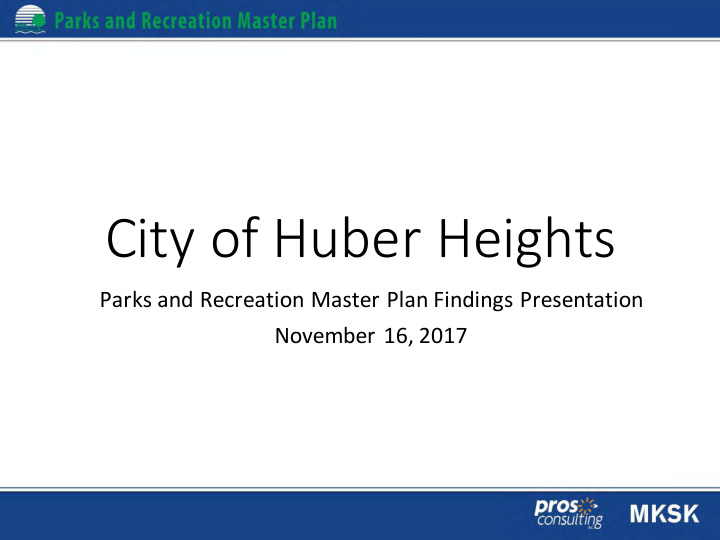



City of Huber Heights Parks and Recreation Master Plan Findings Presentation November 16, 2017
Agenda • Research Process • What We Have Learned • Next Steps • Discussion
Process Overview Where Are We Going Tomorrow? Needs prioritization Site & facility assessments Management standards Programs & service Capital improvement planning assessments • Community outreach Funding and revenue planning Park classification and level • Statistically -valid survey Strategic action plan of service standards • Online survey Related plans review • Demographics and trends analysis • Stakeholder interviews and focus groups Where Are We How Do We Get Today? There?
“Data Packs” The research process includes : • Demographics and Trends • Site Assessments • Interviews and Focus Groups • Public Forums • Recreation Program Assessment • Statistically -Valid Survey • Level of Service (LOS) and Park Classifications •
Wha hat We Have ve Learne ned • Demographics • Population is aging • Population is diversifying
Local Trends Analysis (MPI) • Measured by Market Potential Index (MPI) • National average = 100 Visiting an Indoor Water Park Cycling ( 105) • • (126) Walking for Exercise ( 105) • Baseball (119) Weight Lifting ( 103) • • Golf ( 114) Fishing ( 102) • • Softball ( 114) Aerobics ( 101) • • Volleyball ( 107) Football ( 101) • • Canoeing/Kayaking ( 106) Basketball ( 100) • • Swimming ( 106) • Boating (105) •
Site Assessments Reviewed all park sites • Used a form to ensure consistency across the system •
Site Assessments • Most corrective actions needed pertained to surface/mulch replenishment, tree debris removal/stump grinding, edging repairs, structure supports, equipment repairs
Site Assessments The parks are a blank canvas for activation (repurposing, • more events, connectivity)
Site Assessments Athletic fields receive little to no rest time •
Stakeholder Interviews and Focus Groups The City ’s park acreage is largely a blank canvas • Huber Heights is a “Sports Town” • Much competition among local sport organizations • The community is in need of more comprehensive • recreational programming There is a lack of ADA compliance throughout the system • Opportunities exist for partnerships, sponsorships, and • alternative funding Great cities have great parks and recreation systems •
Public Forum Facilities
Publ blic ic Fo Forum Programs
Publ blic ic Fo Forum Communication
Public Forum Open Comment ADA compliance • Carriage Trails park space • New facility types: • Dog park • Skate park • Ice rink • RC park • More special events and park programming • Re -layout parks • *Girl Scout troop desires to assist with park improvements!
Recreation ion Prog ogram Assessment Active Preschool Elementary Teens Adult All Ages Core Program Area Adult (5 & under) (6-12) (13-17) (18-54) Programs (55+) P P S S S Aquatics P P S S S Sports S S P P P Health and Wellness P P P S S Youth and Family
Recreation Program Assessment Lifecycle Actual Program Best Practice Description Stage Distribution Distribution Introduction New program; modest participation 9% Take-off Rapid participation growth 6% 49% 50-60% Growth 34% Moderate, but consistent population growth Mature 48% 48% 40% Slow participation growth Minimal to no participation growth; extreme Saturated 8% competition 3% 0-10% Decline 3% Declining participation
Recreation Program Assessment Pricing determined by: • Residency or member status • By customer ’s ability to pay • Cost recovery not necessarily a focus • Market duplication kept to a minimum due to programming • structure
Recreation Program Assessment • Core programs are currently well-suited to address the programmatic needs of the current population demographic • Additional programs to consider include: • Squash • Boxing • Lacrosse • Rugby • Roller hockey • Field hockey
Recreation ion Prog ogram Assessment Should the City desire to have a broader range of programs, the • conversation needs to be about: • Expanded recreation programming topics Bringing programs into the parks •
Recreation ion Prog ogram Assessment Core programs are currently well-suited to address the • programmatic needs of the current population demographic Additional programs to consider include: • Squash • Boxing • Lacrosse • Rugby • Roller hockey • Field hockey •
Statistically-Valid Survey Conducted by ETC Institute • Mailed to random sample of households • Goal: 375 • Completed: 385 • Survey report will be developed in the next two weeks •
Level of Service (LOS) Analysis • Excel
Demographic Analysis
Demographic Analysis
Demographic Analysis
Demographic Analysis
Next Steps Statistically -valid community survey results • Online survey results • Level of service analysis finalization • Equity mapping • Needs assessment report •
Project Team Information PROS Consulting MKSK Austin Hochstetler Matthew Leasure Senior Project Manager Associate (574) 209-0687 (614) 621-2796 Austin.Hochstetler@prosconsulting.com mleasure@mkskstudios.com Nick Deardorf Consultant (317) 450-1657 Nick.Deardorf@prosconsulting.com
Recommend
More recommend